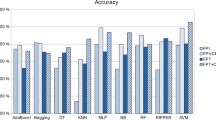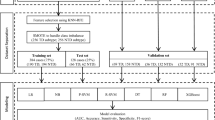Abstract
Purpose
To contribute to the differentiation of Parkinson’s disease (PD) and essential tremor (ET), we compared two different artificial neural network classifiers using 123I-FP-CIT SPECT data, a probabilistic neural network (PNN) and a classification tree (ClT).
Methods
123I-FP-CIT brain SPECT with semiquantitative analysis was performed in 216 patients: 89 with ET, 64 with PD with a Hoehn and Yahr (H&Y) score of ≤2 (early PD), and 63 with PD with a H&Y score of ≥2.5 (advanced PD). For each of the 1,000 experiments carried out, 108 patients were randomly selected as the PNN training set, while the remaining 108 validated the trained PNN, and the percentage of the validation data correctly classified in the three groups of patients was computed. The expected performance of an “average performance PNN” was evaluated. In analogy, for ClT 1,000 classification trees with similar structures were generated.
Results
For PNN, the probability of correct classification in patients with early PD was 81.9±8.1% (mean±SD), in patients with advanced PD 78.9±8.1%, and in ET patients 96.6±2.6%. For ClT, the first decision rule gave a mean value for the putamen of 5.99, which resulted in a probability of correct classification of 93.5±3.4%. This means that patients with putamen values >5.99 were classified as having ET, while patients with putamen values <5.99 were classified as having PD. Furthermore, if the caudate nucleus value was higher than 6.97 patients were classified as having early PD (probability 69.8±5.3%), and if the value was <6.97 patients were classified as having advanced PD (probability 88.1%±8.8%).
Conclusion
These results confirm that PNN achieved valid classification results. Furthermore, ClT provided reliable cut-off values able to differentiate ET and PD of different severities.




Similar content being viewed by others
References
Benamer HTS, Patterson J, Grosset DG. Accurate differentiation of Parkinsonism and essential tremor using visual assessment of 123I-FP-CIT SPECT imaging: the 123I-FP-CIT study. Mov Disord 2000;15(3):503–10.
Marshall V, Grosset D. Role of dopamine transporter imaging in routine clinical practice. Mov Disord 2003;18(12):1415–23.
Antonini A, Berto P, Lopatriello S, Tamma F, Annemans L, Chambers M. Cost-effectiveness of 123I-FP-CIT SPECT in the differential diagnosis of essential tremor and Parkinson's disease in Italy. Mov Disord 2008;15;23(15):2202–9.
Van Laere K, Varrone A, Booij J, Vander Borght T, Nobili F, Kapucu OL, et al. EANM procedure guidelines for brain neurotransmission SPECT/PET using dopamine D2 receptor ligands, version 2. Eur J Nucl Med Mol Imaging 2010;37(2):434–42.
Hamilton D, List A, Butler T, Hogg S, Cawley M. Discrimination between parkinsonian syndrome and essential tremor using artificial neural network classification of quantified DaTSCAN data. Nucl Med Commun 2006;27(12):939–44.
Specht DF. Probabilistic neural network. Neural Netw 1990;3(1):109–18.
Breiman L. Hinging hyperplanes for regression, classification and function approximation. IEEE Trans Inf Theory 1993;39(3):999–1013.
Deuschl G, Bain P, Brin M. Consensus Statement of the Movement Disorder Society on tremor. Ad hoc Scientific Committee. Mov Disord 1998;13 Suppl 3:2–23.
Hoehn M, Yahr MD. Parkinsonism: onset, progression, and mortality. Neurology 1967;17:427–42.
Wasserman PD. Advanced methods in neural computing. New York: Van Nostrand Rei Synopsis; 1993.
Breiman L, Friedman JH, Olshen RA, Stone CJ. Classification and regression trees. London: Chapman and Hall/CRC Press; 1984.
Page PA, Howard RJ, O’ Brien JT, Buxton-Thomas MS, Pickering AD. Use of neural networks in brain SPECT to diagnose Alzheimer’s disease. J Nucl Med 1996;37:195–200.
Hamilton D, O'Mahony D, Coffey J, Murphy J, O'Hare N, Freyne P, et al. Classification of mild Alzheimer's disease by artificial neural network analysis of SPET data. Nucl Med Commun 1997;18(9):805–10.
Warkentin S, Ohlsson M, Wollmer P, Edenbrandt L, Minthon L. Regional cerebral blood flow in Alzheimer's disease: classification and analysis of heterogeneity. Dement Geriatr Cogn Disord 2004;17(3):207–14.
Acton PD, Newberg A. Artificial neural network classifier for the diagnosis of Parkinson's disease using [99mTc]TRODAT-1 and SPECT. Phys Med Biol 2006;21;51(12):3057–66.
Author information
Authors and Affiliations
Corresponding author
Additional information
An erratum to this article can be found at http://dx.doi.org/10.1007/s00259-010-1547-5
Rights and permissions
About this article
Cite this article
Palumbo, B., Fravolini, M.L., Nuvoli, S. et al. Comparison of two neural network classifiers in the differential diagnosis of essential tremor and Parkinson’s disease by 123I-FP-CIT brain SPECT. Eur J Nucl Med Mol Imaging 37, 2146–2153 (2010). https://doi.org/10.1007/s00259-010-1481-6
Received:
Accepted:
Published:
Issue Date:
DOI: https://doi.org/10.1007/s00259-010-1481-6




